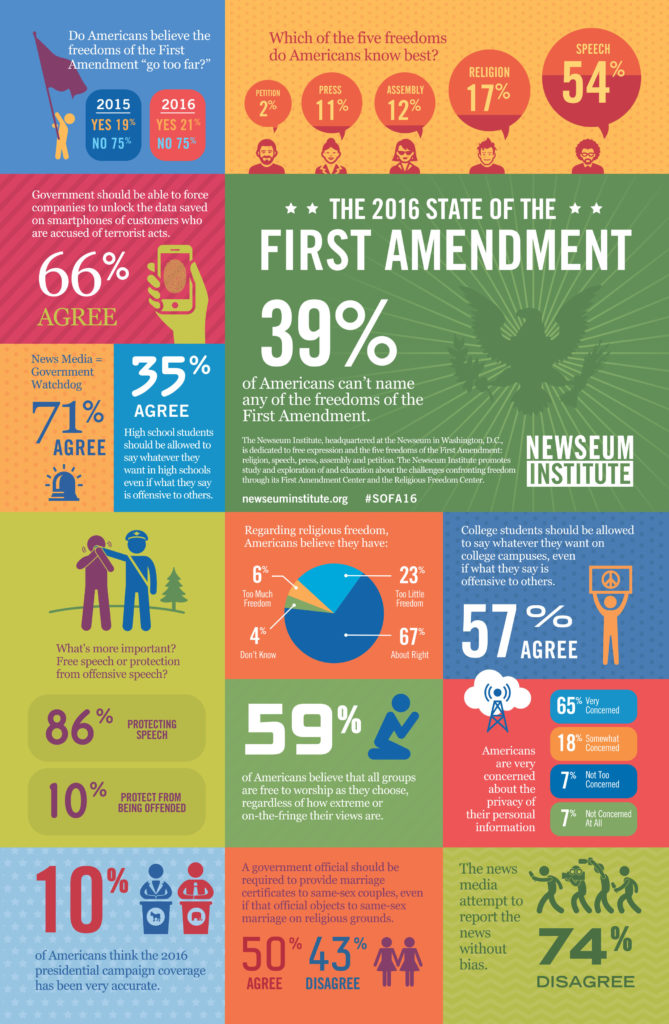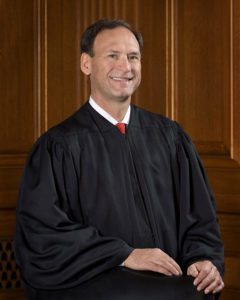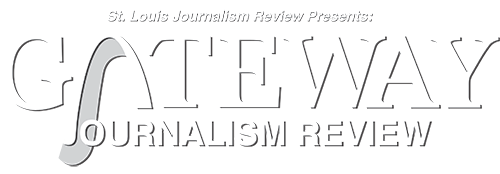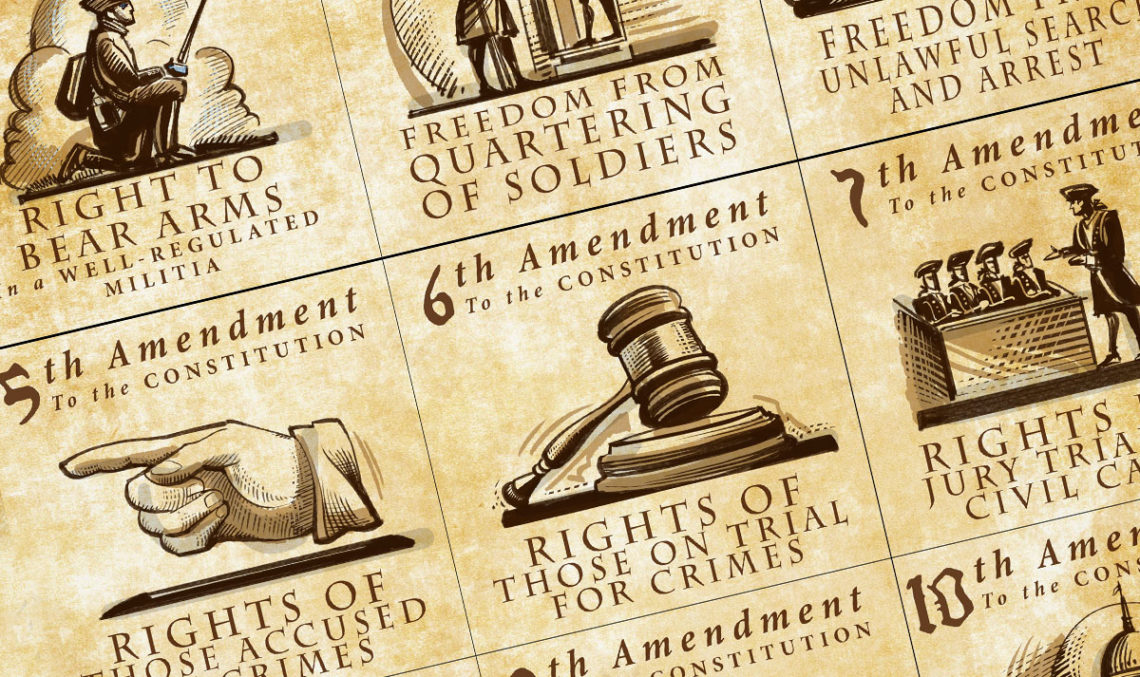When America celebrated the 200th birthday of the Bill of Rights in 1991, no one foresaw the powerful forces that would remake it over the next quarter century.
- The communications revolution and rise of Facebook-Twitter-Google democracy
- The loss of privacy to unforeseen technology
- Sept. 11, 2001, and the growth of the national security state
- Citizens United and the flood of big money into elections
- The Wild West of a virtual public forum flooded with news, fake news and hate speech
- The nation’s fascination with guns and expansion of Second Amendment rights
- The evolving decency that ended the execution of juvenile killers
By 1991, the First Amendment had developed into a powerful shield against government abuse of outsiders, leftists, anarchists, communists, labor unions, Jehovah’s Witnesses, atheists and non-Christians.
“The Bill of Rights is a born rebel,” wrote Frank I. Cobb, a 20th century news reporter. “It reeks with sedition. In every clause it shakes its fist in the face of constituted authority… It is the one guarantee of human freedom to the American people.”
But in the past 25 years the Bill of Rights has put on a business suit. Today it increasingly protects the wealthy, corporations, conservatives, fundamentalist Christians, property owners and other moneyed interests.
“The court has put much more energy into expanding the free speech rights of politically or economically powerful speakers, while largely disdaining the First Amendment concerns of politically and economically disempowered speakers” says Gregory P. Magarian, law professor at Washington University and former Supreme Court Clerk.
In 1991, liberals worried the conservative Supreme Court would cut back on civil liberties. In 2016 many liberals fear the Supreme Court has granted too many new rights.
Liberals often find themselves calling for less-expansive rights:

- Fewer free speech rights for corporations and rich people to influence elections. More restrictions on campus speech in the form of trigger warnings and rules against “micro-aggressions.”
- Less religious freedom for conservative Christians to refuse to bake a cake for a same-sex couple or to fill a prescription for the morning-after pill.
- Fewer rights for gun owners.
- Fewer free speech rights for workers who don’t want to pay union dues.
- Fewer property rights to block environmental regulations of beachfronts and wetlands to preserve endangered species.
By contrast, many conservatives worry that liberals’ restrictions on freedoms can leave elections in control of the big media corporations, can enforce political correctness on campus and in society, can force God-fearing pharmacists, bakers and florists to compromise deeply held religious beliefs, can take away guns from law-abiding citizens and subject property owners to extreme environmental regulations.
And then there is President-elect Donald Trump, a force of his own, who ran a campaign opposed to political correctness but who now complains about speech he finds incorrect — from burning the flag to investigative journalism and an actor’s critical speech from the stage production Hamilton. Playhouses are supposed to be “safe” spaces, Trump says, but campus rules intended to make minorities feel safe are political correctness. Trump advocates laws criminalizing flag-burning and making it easier to win libel awards from media, even though those laws would be unconstitutional violations of the First Amendment.
What follows are some of the most important changes that have occurred in the Bill of Rights in the quarter century between its 200th anniversary in 1991 and its 225th this Dec. 15.
Communications revolution — what press?
In 1991 there was no Internet, no Google, no Facebook, no Twitter, no smart phone, no Fox News, no Huffington Post, no Breitbart and no WikiLeaks. Rush Limbaugh was just starting right-wing radio rants. There were no likes or tweets or citizen journalists. The golden age of legacy journalism sailed obliviously on, like the Titanic toward an unseen iceberg. The notion that millions of tweets could overwhelm the narratives of professional journalists was unimaginable. So was the idea that a president could get elected partly on the strength of 140 character messages insulting opponents and private Americans. Or that “publisher” Julian Assange would become the purveyor of documents hacked from the Democratic Party by Russian spies. Or that thousands of “chatbots” — online robots with artificial intelligence — would post fake news across the Internet in the days before the 2016 election.
Watergate forgotten
 At the same time the communications revolution has transformed speech in the public space, unlimited election spending by corporations, labor unions and the wealthy has transformed political campaigns. Watergate’s lesson of “follow the money” is a distant memory. Thanks to Citizens United, corporations have a First Amendment right to spend as much money as they want on the election of a candidate and the voters don’t get to know who gave millions until after the election. Campaign spending for the two major presidential candidates exceeded $2 billion this year, more than four times that of 1992 when candidates still relied on the now defunct post-Watergate public financing system.
At the same time the communications revolution has transformed speech in the public space, unlimited election spending by corporations, labor unions and the wealthy has transformed political campaigns. Watergate’s lesson of “follow the money” is a distant memory. Thanks to Citizens United, corporations have a First Amendment right to spend as much money as they want on the election of a candidate and the voters don’t get to know who gave millions until after the election. Campaign spending for the two major presidential candidates exceeded $2 billion this year, more than four times that of 1992 when candidates still relied on the now defunct post-Watergate public financing system.
National security state
1991 was a decade before 9/11. No one imagined terrorists bringing down the World Trade towers and attacking the Pentagon. There was no Patriot Act. No prison at Guantanamo to circumvent due process. No drones to kill enemy combatants on foreign soil. The United States was a proud adherent of the Geneva Convention and its bans on torture. Waterboarding was something other nations did. Roundups of men from the Middle East seemed like a bad dream from another era, like the discredited roundups of Japanese-Americans during World War II.
But in the scary time after 9/11, Attorney General John Ashcroft rounded up young Middle Eastern men, triggering a legal case only now playing out before the Supreme Court where the men say they were targeted for their religion. Today’s America is frightened too. The incoming Trump administration talks about banning refugees, deporting immigrants and reinstating torture.
Surveillance state
The thought that the National Security Agency could collect metadata on all Americans’ telephone calls was preposterous in 1991. The Global Positioning System was for the military, not consumers. A person’s location was not constantly tracked by a cell phone in the pocket. Consumers’ purchases were not constantly tracked by their online searches. And street corners weren’t under 24-hour surveillance from ubiquitous security cameras.
Only science fiction had thought of technology such as today’s Stingray system for picking up phone conversations from outside a building. No one needed a right to be forgotten. But as the sweep of the modern surveillance state began to sink in, the Supreme Court pushed back, ruling the government needed a warrant before putting a GPS device on a suspect’s car or searching a person’s cell phone.
Disappearing right of privacy
The right of privacy – a right found in parts of the Bill of Rights and in the constitutional protection of “liberty” – was under assault as the Bill of Rights turned 200. It is under assault again at 225. The Supreme Court of 25 years ago was about to hear a case threatening to read the abortion right out of the Constitution. But the court held to precedent. Not only did it reaffirm Roe v. Wade, but it later expanded that right of individual liberty to encompass same- sex marriage – an expansion almost no one would have predicted in 1991 when not a single state permitted same-sex marriage.
But the right of privacy continues to have shallow roots in the Constitution. Many conservatives say these are unenumerated rights that do not deserve constitutional protection. Replacing the late Antonin Scalia and any one of the three oldest justices with two more Scalias could end the constitutional protections for abortion and same-sex marriage.

Political correctness: equality vs. freedom
The tensions between freedom and equality – two great values of the U.S. Constitution and democracy – have intensified. In 1991 political and religious conservatives were realizing the First Amendment’s protection of religious freedom and free expression could protect them against what they saw as an overbearing political correctness embodied in college speech regulations. Today, liberals and conservatives alike worry that trigger warnings, safe spaces and identity politics can stand in the way of a university’s core liberal purpose of challenging a student’s unexamined assumptions.
Last year, Melissa Click, then a communications professor at the University of Missouri, tried to block a student journalist from taking a photo of black protesters who, she said, needed safe space. Click’s attempt to impose a kind of political correctness on the photographer ran into another form of political correctness from the Missouri Legislature, which demanded her job and got it.
Nationwide, blackface and redface Halloween costumes led to an uproar at Yale, Mexican-American costumes to an apology at Louisville and the University of Oklahoma kicked out a student singing a KKK lynching song on a university bus.
More state support for religion
Since 1991, the Supreme Court has banned public school sponsored graduation prayers, prayers at the Friday night football game and the Ten Commandments on courtroom walls or courtroom monuments. But in a break from the past, the court approved state-funded vouchers for parochial school children. And, in a current Missouri case, the court may allow the state to pay for rubber playground materials for Trinity Lutheran pre-school in Columbia, despite a state constitutional provision that sets up a stricter separation between church and state than the First Amendment. The Supreme Court also opened the way for prayers by local pastors before city council meetings and state and national monuments with religious texts or symbols, such as a six-foot monument of the Ten Commandments on Texas Capitol grounds and the Mojave Memorial Cross built on public land to honor veterans.
Religious freedom
Anyone taking the time-machine from 1991 straight to 2016 would have trouble figuring out what had happened to religious liberty. Scalia cut back constitutional protection for religious liberty in the 1990 Employment Division v. Smith decision, where Native Americans sought protection for their use of peyote in a sacramental ritual. Scalia said the state could enforce generally applicable state laws – such as those penalizing those using peyote – even if those penalized were exercising their religious freedom. With largely Democratic support, Congress passed the Religious Freedom Restoration Act to overturn Smith and restore a higher level of protection for religious liberty. Now conservative legislators are passing state versions of that law to enable florists and bakers to avoid serving same-sex couples based on religious belief. The Supreme Court also used the federal RFRA to recognize the religious freedom of a corporation, Hobby Lobby, to object to contraception requirements of the Affordable Care Act.
Big data
“Big data” – the computer analysis of huge data bases – didn’t exist in 1991, but now the Supreme Court protects it. In a 2011 Vermont case, the court ruled the state could not prohibit pharmaceutical companies from obtaining data on doctors’ prescription writing practices. The companies wanted the data to market their more expensive, brand-name drugs to doctors. Vermont had tried to block the release of this prescription information to protect the privacy of the doctor-patient relationship and to keep down health-care costs. Justice Anthony M. Kennedy wrote that the First Amendment keeps the state from singling out “disfavored speech by disfavored speakers” – the disfavored speech being the marketing of brand-name drugs and the disfavored speakers the pharmaceutical companies. Mark Sableman, a media lawyer at Thompson Coburn in St. Louis, says protecting big data is important to modern journalism that often is based on computer-assisted reporting that analyzes huge government databases.
Fascination with guns
In 1991, Missouri, Illinois and most Midwest states had laws against carrying concealed guns. A few years later Congress banned the manufacture of assault rifles. Now tables have turned. The federal assault rifle ban has lapsed and not a single state bans concealed guns. Faced with an insatiable appetite for guns, all states have either passed laws ending regulation of guns – such as Missouri – or adopted “must issue” laws, such as Illinois, that institutionalize concealed carry. Stand-your-ground and Castle doctrines provide legal protection for using a gun to defend oneself or property. Meanwhile, the conservative majority on the Supreme Court turned its back on precedent and for the first time recognized an individual right to own a gun to protect the home. The decision left plenty of room to regulate assault rifles and concealed guns, but pro-gun majorities in many legislatures, such as Missouri, claim gun laws take away Second Amendment rights. Although the claim is inaccurate, the gun lobby uses it effectively.
Ending juvenile death penalty
By 1991, most states had passed a new generation of death penalty laws, responding to a 1970s decision that found traditional laws arbitrary and capricious. Twenty-two juveniles were executed between 1985 and 2003. Only Iran executed more young people. Christopher Simmons awaited execution in Missouri for murdering Shirley Crook by tying her to a chair and throwing her into the Meramec River. But in the Simmons case the Missouri Supreme Court led the movement to end execution of murderers 17 and younger. The U.S. Supreme Court agreed, finding that the nation’s and world’s evolving standards of decency no longer permitted executing teens because their brains still were developing. Capital punishment for juveniles was therefore deemed cruel and unusual punishment under the Eighth Amendment. Life imprisonment without parole also violated this standard of decency.
Meanwhile, in Illinois, the Innocence Project, run by former Northwestern University journalism professor David Protess, uncovered more than a dozen cases of wrongful convictions in murder cases. Gov. George Ryan ended executions. Nationally, the number of executions, which had increased to almost 100 a year by the end of the 20th century, has dropped almost every year; 28 people were executed in 2015 and 18 this year through mid-November.
What’s liberal and what’s conservative?
Taken together, the changes over the past 25 years have mostly broadened and strengthened the Bill of Rights and at the same time protected new conservative causes.
The Earl Warren court of the 50s and 60s protected communists, civil rights protesters, the Ku Klux Klan, a young man wearing a “Fuck the draft” jacket in a courthouse. It protected the media from President Nixon’s attempt to stop the presses printing the Pentagon Papers. And New York Times v. Sullivan protected the northern media from the attempts of southern politicians to bankrupt them for aggressive reporting of the Civil Rights Movement.
During the Rehnquist court the speech of outsiders continued to flourish with protection of flag-burning, Margaret Gilleo’s anti-war sign in the window of her Ladue home and the ribald parody that Hustler magazine printed of the Rev. Jerry Falwell having sex “for the first time” with his mother in an outhouse. But there were signs of change in rulings protecting religious majorities and rejecting hate crime laws.
In the Roberts era, the winners in First Amendment cases have more often been established interests. People who used to be insiders are sometimes on the outs with liberal political majorities – corporations making political expenditures, pharmaceutical firms seeking to use big data for marketing efforts, corporations such as Hobby Lobby objecting on religious grounds to Obamacare rules on contraceptives. Labor unions, already threatened by expansion of right to work laws, now are on the brink of losing the power to charge union dues to workers who say union activities violate their free speech rights.
Whereas the great free speech decisions of the 60s and 70s were sparked by the court’s liberal justices, its conservative justices now are often more likely to support First Amendment claims – such as Citizens United, where the five justices in the majority were the most conservative five.
One factor in the change was the growth of conservative legal advocacy. The Federalist Society, Pacific Legal Foundation, Liberty Counsel and Center for Individual Rights all took a page from the successes of the ACLU, NAACP Legal Defense Fund and Ralph Nader. The ACLU, LDF, and Nader’s groups had won victories for blacks, consumers and students who didn’t want to be forced to pray in school. The new conservative legal groups began winning for white students who felt disadvantaged by affirmative action, Christian students who wanted to meet in campus buildings and property owners fighting environmental regulations that interfered with their property.

Roger Goldman, a professor at Saint Louis University Law School, wonders whether today’s conservative justices would have supported the free speech decisions of half a century ago. “I’m wondering if Roberts and the conservatives would have joined the liberals in the old First Amendment cases involving communists, loyalty oaths, obscenity, etc.,” he wrote in an email. “In other words, (I’m wondering whether) the new conservatives disagree with the old conservatives of the 40s thru the 90s.”
Professor Joel Goldstein, also at Saint Louis University, raises the opposite question. Justice Louis Brandeis was one of the great architects of First Amendment law in the 1920s, but Goldstein says Brandeis might have dissented from a decision giving First Amendment protection to the Rev. Fred Phelps who picketed the Catholic funeral of Marine Lance Corporal Matthew Snyder, killed in action in Iraq.
Phelps’ Westboro Church says God is punishing the United States for homosexuality. The signs the church members carried read: “God Hates the USA/Thank God for 9/11,” “America is Doomed,” “Don’t Pray for the USA,” “Thank God for IEDs,” “Thank God for Dead Soldiers,” “Pope in Hell,” “Priests Rape Boys,” “God Hates Fags,” “You’re Going to Hell” and “God Hates You.”
Roberts likened his decision to free-speech precedents of the past, including the flag-burning decision, the New York Times v. Sullivan libel decision and Cohen v. California permitting a war protester to wear into a courthouse a jacket with the words “Fuck the Draft.”
In New York Times v. Sullivan, Justice William J. Brennan Jr. wrote the First Amendment required enough breathing space to allow news organizations to make mistakes about public officials. Chief Justice Roberts said that Westboro protesters were addressing issues of public concern and needed breathing space as well.
Just as the court had once upheld a parody of the Rev. Falwell’s “first time”with his mother in an outhouse, Roberts said that the Westboro protesters hyperbole was protected.
But Goldstein doubts Brandeis would have gone along. “Brandeis wrote one of the most powerful justifications of free speech…,” Goldstein said, “yet also believed in a right to privacy… Although I am always skeptical of claims regarding how someone who has been dead for nearly 70 years would have reacted to contemporary circumstances, it’s hard for me to believe Brandeis would have thought a funeral was a constitutionally protected venue for speech attacking the decedent.
“…If we as a society recognize a right to privacy that goes beyond spatial confines, I would think that a funeral would rank at or near the top of experiences where the claims would be strongest. Surely someone who is grieving the loss of and burying a loved one in engaged in one of the most poignant of life’s experiences….”
Alito v Lessig
Today the calls for constitutional amendments or constitutional conventions are as likely to come from liberals as conservatives.
Some liberal groups would like to see constitutional amendments that protect positive rights, such as the right to an education, health care and housing. The current Bill of Rights protects negative rights – blocking government abuses of the people.
Some conservative groups would like amendments to ban burning the American flag, redefine citizenship, require a balanced budget and protect victims of crime.
One amendment that has gotten quite a bit of attention is advanced by Harvard Law Professor Lawrence Lessig and liberal groups for overturning Citizens United by enabling Congress to regulate political spending and contributions. Forty senators have signed on to the amendment.

Justice Samuel Alito, one of the leading conservatives on the court, made it clear in a speech to the conservative Federalist Society after Trump’s election, that he and other conservatives oppose that amendment and others that would undo the conservative handiwork of the past 25 years that expanded the First and Second amendments.
“More than 40 senators have proposed an amendment to the First Amendment, which in itself is an important development,” Alito said. “And what would that amendment do? It would have the effect of granting greater free speech rights to an elite group, those who control the media, than to everybody else.”
Alito also worried that a more liberal court could overturn the 2008 Heller decision recognizing an individual’s right to own a gun. He called that opinion “perhaps Justice Scalia’s most important majority opinion.”
Alito mocked the University of California’s suggestion that the term “melting pot” was a micro-aggression offending minorities. He questioned campus speech codes as inconsistent with a famous line from Justice Robert Jackson’s opinion in 1943 holding that students who were Jehovah’s Witnesses didn’t have to salute the flag because of their belief it was a graven image.
Jackson wrote then, “If there his a fixed star in our constitutional constellation, it is that no official, high or petty, can prescribe what shall be orthodox in politics, nationalism, religion or other matters of opinion.”
Alito added, “On college campuses, both public and private, a new orthodoxy rules. Suppose a student were to test Justice Jackson’s proposition today by wearing an article of attire supporting a political candidate who was unpopular among students and professors by proclaiming that the United States is a great and a good country and by expressing certain traditional religious beliefs.
“How would that go over?”
In the passionate pleadings of both left and right there is a common thread: Something is wrong with our democracy, whether you call it the Facebook Democracy, the Post-Fact Democracy, the Digital Democracy, the Virtual Democracy, the Surveillance State or the Politically Correct Democracy. The great task of the 21st century is adapting democracy to the rapid expansion of freedoms, the flood of information and disinformation and the new gadgets of communication that are just as likely to invade privacy as to connect us to the rest of the world.


No Comments